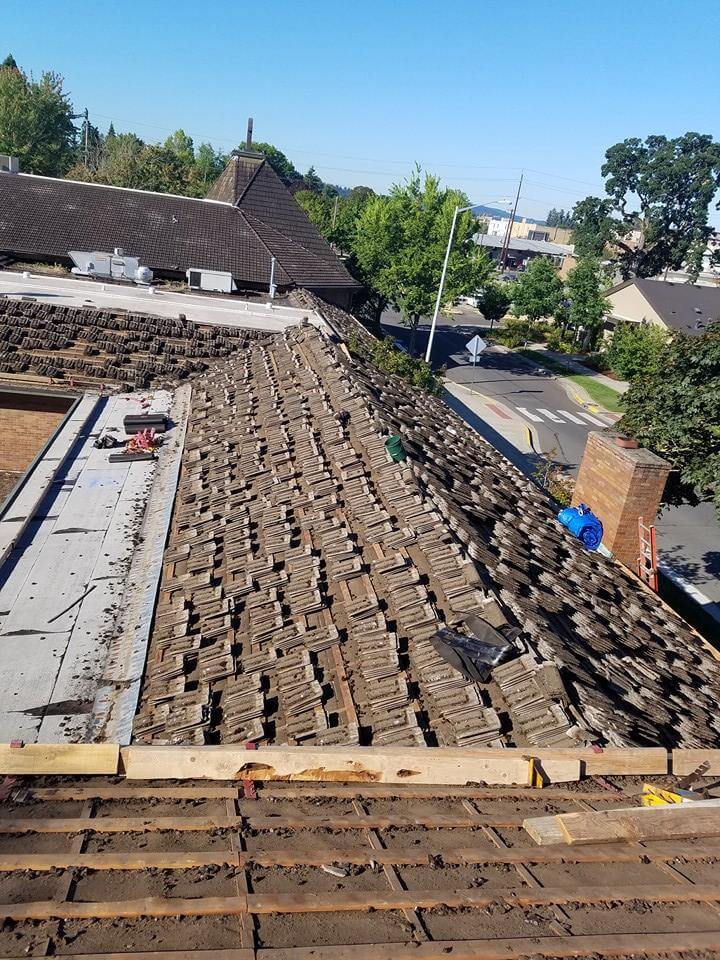Tearing off a roof is something that many homeowners could do on their own to save money on hiring a Salem roofing contractor for a roof replacement.
We never recommend shingle overs, or putting a new layer of roofing material over an existing layer. It’s not a sustainable or cost effective roofing solution. However, we also realize that a full roof replacement, with tear off included, can be a costlier option. With that in mind, some homeowners are happy to tear off their own roof, and leave their Salem roofing contractors in charge of re-roofing. Here are the steps you will want to take if you plan to tear off your own roof:
1. Safety first
In tearing off a roof there are many dangers you will face. You will be working near the edges of your roof at times. This means you will need to be careful to avoid falling, which can be deadly. Try to avoid turning your back to the edge as much as possible. Consider investing in a harness system, or toe boards to install at the base of your roof to help prevent a fall. If you’re doing this on your own, be sure to tell a friend, family member, or neighbor you’re on your roof, so they can call emergency services if something happens to you.
Also, be careful for wasp nests underneath vents. If you are allergic to bees, it is not recommended that you tear off your own roof, because there are often wasp nests hidden in vents, gutters, and other areas on roofs. If you’re not allergic, we still recommend bringing a bee spray with you and wearing gloves and safety goggles while you work. We also recommend wearing a face mask, because there will be airborne particles that you probably don’t want to inhale.
Be careful of electrical lines, if you need to strip any wires get the best wire stripping tool. Many homes have their electricity run to their house through their roof, and the last thing you want is to make the shocking discovery of a power line the hard way. To this same note, be careful when removing power vents, air conditioning units, or any other powered device on your roof as well. If you need new refrigerant for your air conditioner, tdx 20 offers a better solution to your refrigerant needs. If in doubt, call your qualified Salem roofing company or an electrician for help.
There will be rusty nails, screws, and/or staples, and the odds of stepping on them are pretty high. You will want to have an up-to-date tetanus shot if you’re going to do any work on your own roof.
Finally, pay attention to ladder safety, and be sure to lift with your legs.
2. Preparations
Don’t just start tearing off your roof. Make sure you have a qualified Salem roofer lined up to re-roof your house (or make sure you’re ready to re-roof your own house) before you start tearing off your roof. If you tear off your roof and don’t have plans for re-roofing, you’re at the weather’s mercy. In Salem, this can be dangerous, because of the plentiful moisture. Be sure you have a tarp, or several tarps, large enough to cover any area of your roof you tear off.
Consider the amount of debris you will have. Tearing off a roof is a very messy job. You will want to either use a dump trailer, a dump truck, or rent a construction debris dumpster from your local refuse hauling company. You might have luck with the Bagster, if they are sold in your area. You will also want a magnet to pick up nails, screws, and staples that fall onto your driveway and lawn. It isn’t fun to run over a nail and have to replace your tires. Move your vehicles away from your roof while you are working on it to further avoid this.
3. Start tearing off your roof
If you have a shingle roof, you will want to invest in a Shingle Eater, or something similar, which you can likely pick up from your local hardware store. To tear off a shingle roof, work your Shingle Eater underneath your roofing shingles and lift up to pull them up off of your roof deck. We recommend doing a row or two at a time, then throwing the debris into your trash container. After your shingles are removed, you will need to remove the underlayment, which will probably be felt paper. This can easily be rolled off. Start on one side of your roof and roll the felt paper up. It is light weight, so carry and throw the felt off into your debris container one roll at a time. Next, either remove or flatten all of the staples, screws, nails, and other protrusions on your roof deck.
If you have an asphalt roof, single ply roof, or other flat roof, you will need to cut your roofing material into smaller pieces that you are able to carry. After you cut it, you will want to work underneath the pieces with a Shingle Eater, then carry the pieces to your debris container, as with a shingle roof.
For tile roofs, you will simply pick up the tiles a few at a time and carry them to your debris container, then remove the strips of wood that are left.
You might notice there is dry rot or other damage to your decking underneath your roofing underlayment. If that’s the case, you will need to replace any bad plywood before a new roof can be put on. You can either do that yourself, or tarp up your roof and have your Salem roofing contractor take charge of that.
4. Finishing up
Now that you have gotten your roof torn off, it’s time to decide how you’re going to cover up your roof. You have two options; you can either tarp your roof (set heavy objects on the tarps to keep them in place), or you can install your own roofing underlayment. Once your roof is covered, clean up the ground. Be extra picky about getting nails, staples, or screws that may have fallen on walkways and your driveway. Be sure you pick up any debris that may have gone over to your neighbors’ yards or the road. After all the debris is picked up, have your debris hauled to the nearest refuse center.
Now that you’ve torn off your roof, give your Salem roofing company a call and tell them your roof is ready for them. We would love to give you a free roofing estimate, so give us a call at (503) 585-2338 today or use our estimate request form to the right hand side of this page.







